The Brazilian population is increasingly aging, living alone, and renting homes, according to data released today by the Brazilian Institute of Geography and Statistics (IBGE).
The latest data from the National Household Sample Survey (Pnad) shows that over the past decade, the percentage of individuals aged 60 and over jumped from 11.3% to 15.1%.
Meanwhile, the population under 30 has decreased from 49.9% to 43.3%.
In 2022, the number of households with just one resident made up 15.9% of total homes, an increase from 12.2% ten years ago.

Men were more likely to live alone than women. In addition, the proportion of rented homes reached 21.1%, up from 18.8% in 2016.
The proportion of people who self-identify as black increased from 7.4% to 10.6% between 2012 and 2022.
Regarding racial distribution, the North region had the highest proportion of self-identified black individuals (78.4%).
There remain stark inequalities in access to services. 6.4 million households were not receiving daily water supply in 2022, with the Northeast region being the most affected.
Access to sewage services increased from 68.2% to 69.5% between 2019 and 2022, but significant regional disparities persist.
Lastly, Brazilians are also gaining increased access to consumer goods. Cars are present in 49.8% of households, and motorcycles in 25%.
Access to electricity is near universal, with 99.8% of homes having access in 2022.

